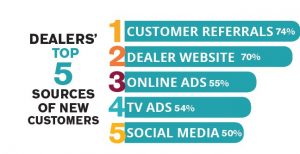The value of display advertising goes well beyond the click. At a time when consumers are hesitant to click on ads because of fraud, clicks are no longer the preferred unit of measure for display ads. Instead, view-through has emerged as a way to quantify display advertising.
Display advertising remains effective in automotive. Per a recent Borrell study, display ads are the third largest source of new customers for dealers[1]. But only a small fraction of a dealer’s customers actually click on your dealership ads, preferring instead to visit your site on their own after seeing the message. View-through helps advertisers gauge the effectiveness of display ads when people don’t click on them.
View-through is an especially effective measure in an era of consumer distrust. Via pixeling, advertisers can see if a consumer saw an ad, did not click on the ad, but then landed on the page pixeled. In a recent survey by Marketing Sherpa, only 39 percent of respondents said that they trusted online banner ads, and another 39 percent said they trusted mobile ads.[2] Translation: there are a lot of people that do not trust ads and therefore will not click on them. But at the same time, the Borrell study suggests that people will look at display ads and are influenced by them, even if four out of 10 consumers say they don’t trust them. Display ads influence buying decisions, and view-through is a great way to track that influence.

So how can you properly assess performance of display ads? Request a tracking pixel from your publisher. Tracking pixels can be created in DFP and tied to your display campaign. The tracking pixel would then need to be implemented across your site. Pixel tracking is an implementation tactic that your site administrator should be familiar with. The pixel should be placed on as many pages as possible, to maximize your conversion.
Industry standard metrics are constantly evolving. As the industry moves away from the traditional click mentality, view-through is a metric that you will want to keep your eye on.
[1] 2016 Auto Outlook: The Thinning of the Media Pack. Borrell Associates. 2016
[2] Marketing Sherpa, “Customer Satisfaction Research Study”, December 12, 2016



